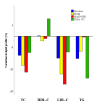Diet and Nutraceutical Supplementation in Dyslipidemic Patients: First Results of an Italian Single Center Real-World Retrospective Analysis
- PMID: 32664400
- PMCID: PMC7400882
- DOI: 10.3390/nu12072056
Diet and Nutraceutical Supplementation in Dyslipidemic Patients: First Results of an Italian Single Center Real-World Retrospective Analysis
Abstract
Background: Dyslipidemias are a heterogeneous group of metabolic disorders mainly characterized by an increased risk of atherosclerotic cardiovascular disease (ASCVD) or other conditions, such as acute pancreatitis in hypertriglyceridemia. The aim of this study was to evaluate the effect of diet treatment and nutraceutical (NUTs) supplementation on the plasma lipid profile in outpatient dyslipidemic subjects, considering the influence of several factors (i.e., gender, age, body mass index, alcohol consumption, and smoking habits).
Methods: 487 dyslipidemic patients spanning from 2015 to 2019 were treated with a Mediterranean diet or NUTs in a real-word setting and were retrospectively analyzed. General characteristics and lipid profile at baseline and after the follow-up period were evaluated.
Results: Diet alone reduced total cholesterol (-19 mg/dL, -7.7%), LDL cholesterol (-18 mg/dL, -10.1%), and triglycerides (-20 mg/dL, -16.7%). Triglycerides (TG) decreased more in men, while women were associated with higher reduction of LDL cholesterol (LDL-C). Different types of NUTs further ameliorate lipid profiles when associated with diet. Nevertheless, most patients at low ASCVD risk (222 out of 262, 81.6%) did not achieve the 2019 ESC/EAS guidelines recommended LDL-C goals (i.e., LDL-C < 116 mg/dL).
Conclusion: Lipid-lowering diet improves lipid profile, and NUTs can boost its efficacy, but taken together they are mainly unsatisfactory with respect to the targets imposed by 2019 EAS/ESC guidelines.
Keywords: EAS/ESC guidelines LDL-C targets; dyslipidemias; hypercholesterolemia; hypertriglyceridemia; lipid lowering diet; nutraceutical supplements.
Conflict of interest statement
The authors declare no conflict of interest.
Figures
References
MeSH terms
Substances
LinkOut - more resources
Full Text Sources
Medical
Miscellaneous



